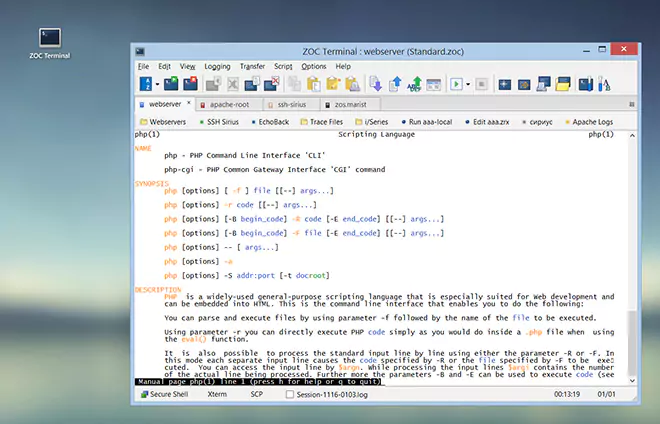Menu Commands → File Menu
The file menu manages all necessary functions to maintain the communication methods (Modem, Telnet or ISDN, etc.) and to connect to a host. Additionally, selected host directory entries can be dialed directly from this menu.
Additionally some methods dependent function may appear in this menu (like Telnet's Are you there). They are described in the method's help text as well).
| Quick Connection | |
This function opens a dialog to allow you to connect to a host as
required, without creating a Host Directory entry (see
Quick Connect).
| |
| Host Directory | |
The host directory is a dialog to maintain your personal dialing directory or
to connect to one or more numbers from it (see
Host Directory).
| |
| Reconnect | |
If a connection was terminated, this function will connect to the same host again.
| |
| Disconnect | |
Disconnects the current connection.
| |
| New Window | |
Opens a new ZOC window.
| |
| New Tab | |
Opens a new tab within the ZOC window.
| |
| Close Window | |
Closes the current ZOC window.
| |
| Print Screen | |
This function lets you print the contents of the terminal window (in
raw ASCII mode).
| |
| Save Screen | |
Saves the contents of the terminal window to the file defined in
Options→Program Settings→Special Files.
If the file already exists, the text will be appended.
| |
| Accept Connections | |
This function enables/disables the auto answer mode of your chosen communication method. The Telnet device will create an incoming port with port number 23. The Serial/Modem handler will send the commands you set up in Session Profile→Connection Type→Serial/Modem→AT-Commands→Modem Options.
In auto answer mode the modem will automatically pick up the phone when the
phone rings and will try to establish a data connection with the calling
modem (of course this is not a good idea when you expect voice calls).
| |
| Stop AutoLogin | |
This function aborts automatic login initiated from a host directory entry
(see Changing Host Directory Entries). AutoLogins
are indicated by the 2nd LED in the status line being pink.
| |
| Call Next in Queue | |
If you select more than one host to call from the host directory, ZOC will
connect to the first of them that is available. After finishing the call
you can select this function to try to reach the next available host.
| |
| Reset Communication | |
This function will reset the connection type to its default state.
For modems this means that the init string defined in the
Modem Options will be sent to the modem to set it
to a defined state. It will do this regardless of the current carrier detect
state.
| |
| Send Break | |
Pulls the data pin of the modem low for a given time (see
Options→Session Profile→Connection Type→Serial/Modem).
This is called sending a break. Some systems use this to reset the connection state or
to stop the current operation. Devices other than the modem will perform a similar
operation or will just ignore this command.
| |
| Connection Type Dependent Functions | |
Some ZOC communication methods (e.g. Telnet) add method dependent functions.
These are described in the input/output devices section
of the help file.
| |
| Connect XXXX | |
At the end of the file menu appear those entries from the host directory that have the Menu Access option enabled (see Changing Host Directory Entries). This is handy for hosts which you call often. | |
← Back to Menu Commands

